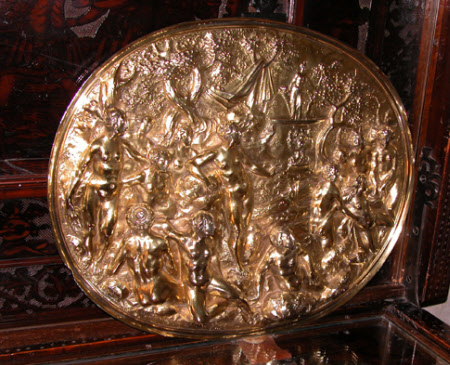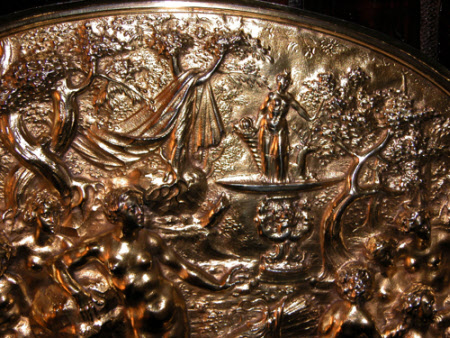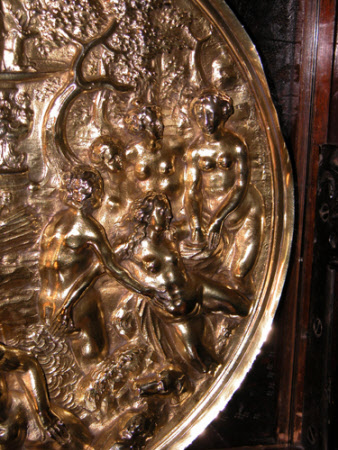Diana and Callisto
Flemish (Antwerp) School
Category
Art / Sculpture
Date
c. 1630 - c. 1640
Materials
Silver-gilt
Measurements
388 mm (Width); 482 mm (Length)
Place of origin
Flanders
Order this imageCollection
Anglesey Abbey, Cambridgeshire
NT 516394
Summary
Silver-gilt, Diana and Callisto, Flemish (Antwerp) School, c. 1630-40. A large oval repoussé silver-gilt relief depicting the discovery of the nymph Callisto’s pregnancy by the followers of Diana, goddess of the hunt. The scene is set within a wooded landscape, with a stream running through the middle. Diana and her nymphs are all naked, after bathing. At centre is the figure of Diana, leaning against a rock, with behind her six of her nymphs, whilst a seventh in the foreground is climbing out of the water. At the right four more nymphs hold captive Callisto, whose advanced pregnancy had become apparent to the others as she bathed along with the others. Diana gestures imperiously towards Callisto, ordering her expulsion from her retinue. Diana’s quiver lies on the rocks to the right of her, whilst in the distance is a fountain, the base formed from a mask entwined with two mermaid figures, whilst in the bowl is a statuette of Diana robed, the crescent moon at her temple, holding a cornucopia and a bow in her hands, a stag lying to her side. The head of a dog just below Callisto at right. The relief was probably made in the Southern Netherlands (Flanders), c. 1630-40, and would originally have formed the well of a large basin. It has however lost its original border, which would have borne marks identifying the maker and the date. The relief is now held within a plain fillet, put on in 1818, when the relief was set within a modern border by an unknown London silversmith, to create a sideboard dish. Although they are not a true pair, the Diana and Callisto is similar to and shares a provenance with another large silver-gilt relief at Anglesey Abbey, depicting the Fall of the Titans (NT 516393).
Full description
This large embossed silver relief is not only a masterly technical achievement, but a remarkable and original rendering of one of the more violent and unpleasant stories in classical mythology. The story, told by the Roman poet Ovid in his Metamorphoses (2: 401-95), concerned Callisto, a nymph of Diana, goddess of the hunt. All Diana’s followers, like their mistress, were vowed to chastity. However, as she slept in the forest, Callisto was spotted by the king of the gods, Jupiter, who took on the form of none other than Diana, allowing him to approach the unsuspecting girl and then rape her. Callisto managed for some time to conceal her resulting pregnancy but, eight months later, as Diana and her nymphs decided to bathe, Callisto’s condition became apparent to her companions, who ripped off her robe and paraded her before their mistress. The affronted Diana at once banished Callisto, who subsequently gave birth to a son, Arcas, but did not punish her further. It was Jupiter’s consort Juno who, furious when she learnt of her husband’s infidelity, transformed Callisto into the body of a bear, whilst the poor girl retained her human mind. She wandered for years, terrified of hunters and wolves, until one day coming across her by then fifteen year-old son Arcas, who was out hunting. Desperate to try to reveal herself to Arcas, Callisto in her animal form lumbered towards her son; fortunately, just before the terrified boy plunged a javelin into the bear, Jupiter took pity, transforming both mother and son into neighbouring constellations. In the seventeenth century, by far the most famous depiction of the discovery of Callisto’s pregnancy was Titian’s great painting of the subject, painted for King Philip II of Spain, today in the National Gallery, London and the Scottish National Gallery, Edinburgh. Like many other subsequent renderings of the scene, the Anglesey Abbey relief follows Titian for the general setting of the scene, in a wooded landscape separated by the brook, and crowded with the figures of the goddess and her nymphs. Some elements in the composition are directly taken from Titian or, more properly, Cornelis Cort’s engraving published in 1566, the earliest of numerous prints derived from the painting, in this case in fact a second version produced by Titian and his workshop, today in the Kunsthistorisches Museum, Vienna. These include the beautiful figure of the nymph seen from the back, in the right foreground of Titian’s painting but on the left in the engraving, the drapery hanging between two trees and the fountain surmounted by a figure of Diana and her hound. The fountain is one of the main differences between the London/Edinburgh and Vienna paintings, in the former an all’antica construction topped by a putto pouring water from a vase, in the Vienna painting a more developed and overtly mannerist affair. Also taken from Titian’s model, albeit less obviously, is the imperious figure of Diana. Beyond these borrowings, the relief appears to be a largely original composition, more ambitious in its scope than a work such as a circular silver relief of the subject in the Victoria & Albert Museum, thought to have been made by a German silversmith working c. 1600, which copies Cornelis Cort’s engraving much more closely (inv.no. M.138-1913. Ingrid Weber, Deutsche, Niederländische und Französische Renaissanceplaketten 1500-1650, 2 vols., Munich 1975, no. 755). The Anglesey Abbey relief is in fact a gripping depiction of the horrific episode of the shaming of Callisto, lacking perhaps the psychological perception that is within Titian’s masterpiece, but instead more overtly violent, in the harsh manner with which Callisto is handled, stripped naked and her legs outspread, to emphasise even more clearly the nature of her humiliation. To make this point the clearer, her enforced pose is echoed in the nymph in the foreground at left. Overall, the composition is more claustrophobic, with a greater number of figures crowded into a smaller space. The designer has taken a certain relish in the overt nakedness of the well-muscled nymphs.There are some less successful elements in the composition, notably Diana’s quiver in the centre of the relief, which seems over-sized next to the figure of the goddess, here shown smaller than in Titian’s composition and thus less dominant. The relief was certainly originally conceived as the well of a large basin or dish, which might in turn have been accompanied by an ewer. Usually basins had a circular ring in the centre, onto which the ewer could be placed, but a small number of spectacular surviving examples from the late sixteenth and early seventeenth centuries dispense with such a space, sacrificing functionality for splendour and display. These objects were made for show and would have been displayed on buffets. One of the most important, the earliest surviving large elliptical basin to dispense with the space for the ewer, is the large basin by Christoph Jamnitzer in the Kunsthistorisches Museum, Vienna, made for the Emperor Rudolf II in 1602, filled with a triumphal procession (Inv. KK 1128, 53 x 64.5 cm. Günter Irmscher, Amor und Aeternitas. Das Trionfi-Lavabo Christoph Jamnitzers für Kaiser Rudolf II, Vienna 1999; Sabine Haag and Franz Kirchweger, eds., Treasures of the Habsburgs. The Kunstkammer at the Kunsthistorisches Museum, Vienna, London 2013, pp. 204-207). A similar formula was adopted by the Utrecht silversmith Paulus van Vianen, who worked for the Emperor Rudolf at his court in Prague, with his magnificent silver ewer and basin with scenes from the life of Diana, signed and dated 1613 (Rijksmuseum, Amsterdam, inv.no. BK-16089-A, B. J. W. Frederiks, Dutch Silver. I. Embossed Plaquettes, Tazze and Dishes from the Renaissance until the end of the Eighteenth Century, The Hague 1952, pp. 157-61, no. 96; A.L. den Blaauwen, Nederlands zilver/Dutch silver 1580-1830, exh. cat., Rijksmuseum, Amsterdam etc. 1979-80, no. 20; Reinier Baarsen, Kwab. Ornament as Art in the Age of Rembrandt, exh. cat., Rijksmuseum, Amsterdam 2018, pp. 34-39, 256, no. 3, figs. 39-42). The style of the Anglesey Abbey relief would suggest that it dates from the period c. 1630-40. The very high relief and the compositional parallels with works by artists such as Jacob Jordaens and Peter Paul Rubens would suggest that it was most probably made in the Southern Netherlands (Flanders), probably in Antwerp, the major centre for the production of high-quality silver in Flanders. There are for example some parallels with the mildly titillating scenes of naked bathing women by the Flemish painter Jacob Jordaens (1593-1678), such as his own version of the Diana and Callisto story (private collection; Joost van der Auwera et al, Jordaens and the antique, exh. cat. Royal Museums of Fine Arts of Belgium and Museumslandschaft Hessen Kassel, Brussels 2012, pp. 236-37, no. 87). The subject seems in fact to have enjoyed some popularity among Dutch and Flemish painters in the early decades of the seventeenth century. Antwerp silversmiths were renowned for the quality and ambition of their work. Among the rare major pieces of Flemish early seventeenth-century silver to survive are three ewers and basins made by Antwerp silversmiths working in Genoa for the Lomellini family (Hugh MacAndrew, ‘Genoese Silver on Loan to the Ashmolean Museum’, The Burlington Magazine, Vol. 114 (September 1972), pp. 611-20), now in Birmingham Museum and Art Gallery, the Victoria and Albert Museum and the Ashmolean Museum, Oxford (inv.nos. WA 1974.234 and 235. A.M. Claessens-Peré, ed., Zilver voor Sir Anthony/Silver for Sir Anthony, exh. cat., Provinciaal Museum Sterckshof, Zilvercentrum, Antwerp 1999, no. 35). A no less spectacular ewer and basin of 1635-36, by the Antwerp silversmith Theodoor I Rogiers (1602-c. 1654) or his father Rombout (c. 1573-1634/38), (Peter Fuhring, ed., Theodoor I Rogiers. Rubens, Silver Ewer and Basin, Brussels 2001; Anne-Marie Claessens-Peré and Wim Nys, Zilver uit Antwerpen, exh. cat., Zilvermuseum Sterckshof, Antwerp 2006, no. 182), probably once owned by Peter Paul Rubens, is today in the Rubenshuis in Antwerp. The well of this basin is decorated with a relief of Susannah and the Elders. The Rogiers family of silversmiths was patronised by King Charles I of England and Scotland. In the inventory of the collections at Whitehall, drawn up by Abraham van der Doort in 1638-39, is listed a series of six embossed silver reliefs, described by van der Doort as ‘driven silver plates’, and specifically identified as the work of ‘Rogeeres’ ‘at Antwerp’. The subjects, all classical and pagan, sound very similar to the Diana and Callisto relief at Anglesey Abbey. They included two circular plaquettes, described as ‘very highe imboast [embossed]’, one with Bacchus carried by two satyrs, accompanied by three more satyrs, and a Rape of Europa. Others featured satyrs and women in landscapes, and Pyramus and Thisbe (Oliver Millar, ed., ‘Abraham van der Doort’s Catalogue of the Collections of Charles I’, The Walpole Society, 37 (1960), pp. 151-52). They would have been considerably smaller than the Diana and Callisto and Fall of the Titans reliefs at Anglesey Abbey, and could well have been the sort of plaques that could be inserted as panels in furniture, such as those adorning a large cupboard in the Victoria & Albert Museum, formerly at Mentmore (inv.no. M.320:1-1977; Anna Somers Cocks, ‘Mentmore Silver-Mounted Cabinet’, The Burlington Magazine, 120 (May 1978), pp. 308-14). Theodoor Rogiers, who became a master-chaser in the guild of St Luke in Antwerp in 1631, was known as a specialist in embossed plaques for furniture (Somers Cocks, p. 311), as well as for his often spectacular creations in silver. He made, to the designs of his friend Rubens, a silver ewer and basin, which do not survive, but which are recorded in an engraving probably published in 1660 (example in V&A, Inv. 24334C; see also Zilver uit Antwerpen, no. 181) as well as in Rubens’s painted modello for the basin, in the National Gallery, London. Whilst neither the Diana and the Callisto nor the Fall of the Titans appear to be by the same hand as the basin in the Rubenshuis, the maker of the Diana and Callisto was working in a similar idiom and at the same very high level. Some idea of what the relief might have looked like with its original rim may be gained from a large ornamental dish with a central relief depicting the story of Cupid and Psyche in the Museo Nacional del Prado, Madrid, made by the Antwerp silversmith Wierick Somers I in 1629-30 (inv.no. O-2725. Silver for Sir Anthony, no. 55), from drawings by the engraver Peter de Jode the Elder. Somers used for that dish drawings by the engraver Peter de Jode the Elder, and it seems almost certain that the silversmith who made the Diana and Callisto would have been working to a preparatory drawing supplied by an artist such as Peter de Jode (1570-1634). If the piece was made in Antwerp it would have contained on the border section the control marks that would have helped to identify the maker and the date of the piece. However, this information is now lost. The rim might well have been in the fluid and highly organic auricular decorative style, pioneered in silver by the van Vianen dynasty of goldsmiths and highly popular in the Netherlands during the first half of the seventeenth century. The Rogiers ewer and basin in the Rubenshuis both for example make extensive use of auricular ornament. The Diana and Callisto and the Fall of the Titans are both examples of a fascinating practice in the London silver trade in the early decades of the nineteenth century, in which Continental reliefs were remounted in modern borders. When the Diana and Callisto was sold from the collection of the Dukes of Buccleuch in 1953, it was described in the catalogue as forming the centre of a larger George III dish, dated 1818. It had probably been imported from the Continent shortly before, and its original border would have been cut away and melted down in London. The relief was then, after its sale in 1953, separated from the 1818 border, which in turn was probably melted down or converted to some decorative use such as a frame for a mirror (see the Edward Farrell frame discussed below). A number of pieces with Continental silver reliefs set inside English nineteenth century borders in fact survive complete, to demonstrate this short-lived fashion. In almost all cases the borders bear similar inscriptions which describe the insertion, usually emphasising that the inserted relief was of ‘unknown Assay’, i.e. the quality of the silver was unknown, sometimes adding that the relief had been set in without the use of any soldering. Thus, for example, a sideboard dish by William Eley II in the Royal Collection (RCIN 51662) consists of a Continental, perhaps Flemish relief of Queen Thomyris with the head of Cyrus, set within a border by Eley marked for 1824-25, and inscribed ‘Sepr 20th 1824 This Rim weighing 112oz, 17dwts, to receive a Medallion weighing 37oz, of unknown Assay to be added without Solder.’ The inscription was needed because Continental silver was often of a standard below sterling silver, so could not otherwise have legally been incorporated into a marked dish. Other examples of the practice, which was presumably intended to make the reliefs look more magnificent and the objects more modern, have appeared in recent years on the art market: a sideboard dish with a centre depicting the Triumph of Scipio Africanus made by a member of the Jaeger family in Augsburg, c. 1660, with an added border attributed to Edward Farrell, c. 1820-30 (Christie’s London, Silver from Wentworth, 15 July 1998, lot 157); a sideboard dish marked by Paul Storr for 1831 incorporating a German relief dated 1759 (Christie’s London, 25 November 2003, lot 271); a casket marked by William Elliott for 1820, incorporating in the cover a seventeenth-century embossed plaque (Christie’s New York, 17 May 2006, lot 98); a silver-gilt rosewater dish, made by Paul Storr for Storr & Mortimer in 1823, with the centre set with a dish by Philipp Müller of Nuremberg, circa 1685 (Sotheby’s London, Arts of Europe, 15 May 2014, lot 370). A frame marked by Edward Farrell for 1830 was also in the 1998 sale of silver from Wentworth (lot 158), converted for use as a mirror, which may have been the fate of the George IV border made in 1818 for the Diana and Callisto. The relief within the William Eley dish in the Royal Collection has a very similar plain fillet to the rims surviving on both the Diana and Callisto and Fall of the Titans reliefs. These rims must have been used so that the reliefs could be inserted into their new borders ‘without solder’. Jeremy Warren 2019
Provenance
Probably acquired by Walter Francis Montagu Douglas Scott, 5th Duke of Buccleuch, 7th Duke of Queensberry (1806-1884); by descent to Walter John Montagu Douglas Scott, 8th Duke of Buccleuch and 10th Duke of Queensberry (1894-1973); sold Highly Important Silver, Sotheby’s London, 25 June 1953, lot 30, ‘A large George III silver-gilt Dish, oval, the centre repoussé in bold relief with “Diana and her Nymphs bathing,” within a strapwork border, the broad flat rim embossed with a repeating design of amorini amid scrolling foliage, 28 ½ in. wide, 1818 – 135 ozs. (approx.), slightly faulty’; purchased Holborn for £95; purchased David Black; sold by David Black to Urban Huttleston Rogers Broughton, 1st Lord Fairhaven (1896-1966), on 27 October 1954, together with NT 516393, for £450; bequeathed to the National Trust by Lord Fairhaven in 1966 with the house and the rest of the contents.
Credit line
Anglesey Abbey, The Fairhaven Collection (The National Trust)
Makers and roles
Flemish (Antwerp) School, sculptor
References
Catalogue of Highly Important Silver […] …the Property of His Grace the Duke of Buccleuch and Queensberry, Sotheby & Co., Thursday, June 15th 1953, p. 6, lot 30.



